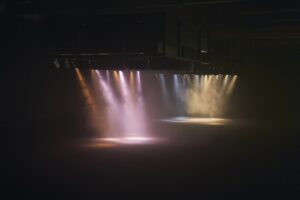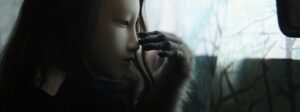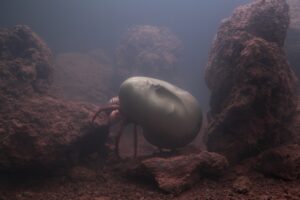“Liminal”, Pierre Huyghe’s new exhibition project, conceived and curated for Punta della Dogana with Anne Stenne, turns out the lights on the reality we know by transporting us to the border of what lies beyond, to places in-between inhabited by creatures at the margins of the conceivable. The exhibition, which can be visited in Venice until 24th November 2024, embodies the latest frontiers reached by the French artist over the last decade, providing the perfect context for a reflection on relational aesthetics and its horizons.

Pierre Huyghe, “Liminal”, 2024 – ongoing. Courtesy the artist and Galerie Chantal Crousel, Marian Goodman Gallery, Hauser & Wirth, Esther Schipper, and TARO NASU © Pierre Huyghe, by SIAE 2023
In 1999, Pierre Huyghe and Philippe Parreno purchased an avatar from a Japanese company, a virtual model intended for commercial animation freed by the two, whose name became Annlee. Before offering Annlee’s acting services to other artists, the two each produced an episode starring her. Annlee, in Two Minutes Out of Time, addressed the viewer with these precise words: «I imagine you. It’s easy… I see you and I see her too». Although in the 2000 work you are not really being observed, inside the Punta della Dogana spaces you actually are.The first room, shrouded in darkness, like all the following ones – a condition that imposes on the visitor an involuntary, as much as inevitable, temporary physiological adaptation to the absence of light – is composed of a corpus of previously unseen works. Liminal, a video reproduced in gigantic dimensions across the entire height of the hall. A faceless woman walks in an absent place, as empty as the space inside her skull that should contain her brain, her mind and the coordinates of her consciousness. Estelarium, lying on the floor in a corner, is the basalt cast of the pregnant belly of a human entity. The shapes of the emptied face and the abyss on which the woman proceeds interpenetrate with those carved inside the lava rock, speculating on the birth of a new non-human life form.

Pierre Huyghe, (from left to right) “Offspring”, 2018, Pinault Collection; “Offspring”, 2018, Courtesy Leeum Museum of Art. Installation view, “Pierre Huyghe. Liminal”, 2024, Punta della Dogana, Venezia. Ph. Ola Rindal © Palazzo Grassi, Pinault Collection
The exhibition and his most recent works succeed in catalysing a method that Huyghe has been experimenting with for decades, to foster that openness towards a liminal experience, feasible as long as attention is kept «[…] on the way processes remain constantly in progress and interpretations are infinite»[1]. Most of the works on display are in fact in perpetual reception – the mastodontic brass totem you encounter in the first room, Portal, is an example – projecting what they pick up through environmental sensors, cameras and microphones, into what we can observe in the real-time simulation of Liminal, or in the self-generated light and sound rhythm of Offspring. The apotheosis of what has been described occurs in the last room, where a large screen reproduces the images of UUmwelt-Annlee, reconstructed in real time from the data collected by a brain-computer interface, which records the cerebral activity of an individual in the act of imagining Annlee and modifies its parameters according to the environmental conditions it records at Punta della Dogana. These inhuman creatures share an existential condition with those who observe them without knowing their nature, contrasting, without making it explicit, the distressing stasis of dasein – “being-there”, as Heidegger defined the human being – by introducing us to erneuerungssein – the renewing being – which is constantly mutating.

Pierre Huyghe, “Untitled (Human Mask)”, 2014, Pinault Collection. Courtesy of the artist; Hauser & Wirth, London; Anna Lena Films, Paris © Pierre Huyghe, by SIAE 2023
When the work is instead in a state of finiteness, in the act of representing other forms of life – as is the case of Human Mask, a film set in the outskirts of Fukushima after the nefarious events from 2011, in which a masked monkey continues to repeat the anthropic gestures to which it has been trained, and in the artificially determined environment of the aquarium in which an arrow crab lives, Zoodram 6 – it is the observer who is pushed towards renewal.

Pierre Huyghe, “Zoodram 6”, 2013. Courtesy Staatliche Museen zu Berlin, Nationalgalerie, 2015 purchased by the Freunde der Nationalgalerie © Pierre Huyghe
“Liminal” opens up new ontologising speculative perspectives, but presents itself, in relation to Pierre Huyghe’s artistic practice, as the closure of a conceptual path that concretises years of research. Huyghe, who at the beginning of his career conceived narratives that could critically oppose those offered by society, seems to have understood that reality and fiction are not opposed. Rather, fiction can override the metaphysical spaces of reality, which is instead contingent on the spaces of unreality, interconnected through a system of communicating vessels. The French artist explores this threshold by leaning, without belonging to it, towards an experiential aesthetics – which is not inspired by reality or an elucubration of it, but is materially constituted by it, and does not propose an artefact, but allows it to be produced by the authentic experience of those who decide to offer themselves – almost going so far as to sublimate those predeterministic characteristics that have allowed Nicolas Bourriaud to frame it in relational aesthetics.
Mattia Caggiano
[1] AA.VV., Pierre Huyghe, a cura di Carolyn Christov-Bakargiev, Skira, 2004
Info:
Pierre Huyghe. Liminal
curated by Anne Stenne
17/03 – 24/11/2024
Punta della Dogana
www.pinaultcollection.com

is a contemporary art magazine since 1980






NO COMMENT